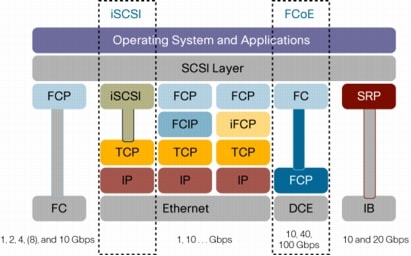LAN & SAN Convergence

As we saw on Albert Teixidor's presentation, nowadays, most organizations have two parallel separated networks on their data centers: a LAN network based on Ethernet to connect servers and clients and a SAN network based on Fiber Channel to connect servers to the storage pool. These separate networks require added expense due to requirements such as increased number of network interfaces, additional cabling and switch ports, and more complex support needs. For instance, on Fiber Channel based SANs, one or more HBAs must be purchased for each server, depending on the redundancy requirements, which adds considerably to capex and opex.
Storage networks can be classified into two categories: storage for IP-based traffic, such as iSCSI, NAS, Internet Fiber Control Protocol (iFCP) and Fiber Channel over IP and storage based on Fiber Channel. Storage for IP-based traffic uses TCP / IP as an underlying protocol so that it can be deployed to the same infrastructure as the LAN. On the other hand, storage based on Fiber Channel forces organizations to have parallel infrastructures for their LAN and SAN networks, with separate switches and HBAs.
Collapsing the two networks into a single one, we achieve the following three benefits:
- Efficiency: eliminate infrastructure redundancy.
- Agility: provides the ability to set up, move, and change both physical and virtual servers faster to easily respond to ever-changing business needs.
- IT transformation: it enables data center consolidation, and supports a capacity demand model that help IT organizations do more with less.

This convergence clashes with the main problem traditional storage systems face: Ethernet networks are limited by the amount of information that can be fitted to an Ethernet frame, which results in limited transfer speeds. To solve this, Cisco created the technology Fiber Channel over Ethernet (FCoE), that encapsulates Fiber Channel frames over an Ethernet network. The IETF IP Storage group, for its part, created the technology Small Computer System Interface over IP (iSCSI). The stack of protocols of both technologies can be found in the following image.

We see how iSCSI uses TCP / IP, while FCoE does not. The main advantages and disadvantages of each of the technologies are summarized in the tables below:
FCoE
| Advantages | Disadvantages |
| Ability to operate with already existing Fiber Channel SANs | It cannot be routed |
| High number of IOPS (compared to iSCSI) |
iSCSI
| Advantages | Disadvantages |
| Open standard | High CPU utilization |
| Easy to set-up and to troubleshoot. |
Overload caused by the encapsulation of iSCSI over TCP/IP, translated to a lower number of IOPS |
We can see that FCoE supports a larger number of I/O operations (IOPS) so that most manufacturers agree that FCoE is more intended for large scenarios, such as a data center with a high budget, while iSCSI would be used on smaller scenarios. However, if you have an infrastructure, you should see which of the two technologies fits you the best.